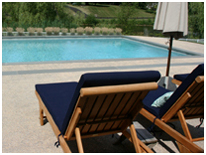Getting Ready to Design a Pool

 In my recent series on exterior design, I made only brief reference to the inclusion of pools and other aquatic features as part of outdoor compositions. I’ll make up for that now with a series of three features on approaching the design of watershapes.
In my recent series on exterior design, I made only brief reference to the inclusion of pools and other aquatic features as part of outdoor compositions. I’ll make up for that now with a series of three features on approaching the design of watershapes.
In most cases, a swimming pool is the biggest investment my clients will make in developing their exterior spaces. Indeed, the cost of the pool itself – excluding the surrounding paving and other amenities – can represent upwards of three-quarters of the total cost they’ll invest in their outdoor environments.
With that in mind, it’s obvious that we need to consider the ramifications of our designs and what their installation entails. After all, we don’t want our clients to make a $100,000 mistake!
Question Time
Once a client signals interest in a pool, I shift into what can best be described as hyper-attentive mode. Where I will ask many questions about a client’s projected use of a patio or favorite plant choices or favorite artists or myriad other garden-space issues, I will ask almost as many questions about the pool alone.
What is the intended use? Is it for swimming, socializing or children at play? All three? Or is it mainly to be a decorative work of art? Will there be diving and a deep end, or will there be a single depth? How about waterfalls, spillways, fountain jets and other active water effects? What about fire elements, beach entries, vanishing edges or swim-up bars or tanning platforms?
This array of choices can overwhelm a client, but these are issues that must be hashed out before pencil goes to paper. And I know that, ultimately, if even one item is missing, a great pool can become a failure in my client’s eyes. And it’s not like a garden, where we can always add few missed plants or remove an undesired one. We can enlarge a patio or add a shade structure, but altering or, in the worst case, removing a pool is no fun at all.
It is imperative, in other words, that we get to the very heart of what our clients want, even if they themselves can’t define or describe it: It is our jobs as designers and installers to pry that information out of them, and there are times when this is no easy process.
Even in those rare cases when a client says, “Do whatever you want, I trust you,” it scares the daylights out of me and I will respond by saying: “It doesn’t matter what I want, because I’ll go home after the job is done. You have to live with it.” Don’t get me wrong: I will always inject my opinions and aesthetic sensibilities and design ideas and creativity into the project, but I will also keep my client’s core desires in mind as I am envisioning the final outcome.
This goes for all aspects of the landscape, but it particularly applies to the pool design.
Tailor-Made
My clients come in all shapes, sizes, ethnicities, and social and financial standings. Some don’t want to swim; instead, all they want to do is stand in a body of water up to their waists, drink in hand, while catching up on the lives of their friends or even doing business.
Others want to swim laps every morning or tan themselves on a platform while still immersed in water. And still others have children who will want to explore the new “ocean” in their backyards, donning their snorkels to search for strange life forms eight feet down or see how much water they can displace with their fanciest cannonballs.
We need to know all about these preferences, expectations and dreams before we run off and start designing. We may not approach these issues with the same vision as our clients – and that’s where the hazards are: If we don’t all find our way onto the same page, then the time we spend designing (and specifying) a very expensive, water-filled hole in the ground will be wasted. Worse, the client won’t be happy.
Next: Thinking about pool design in innovative, creative ways.
Bruce Zaretsky is president of Zaretsky and Associates, a landscape design/construction/consultation company in Rochester, N.Y. You can reach him at [email protected].









